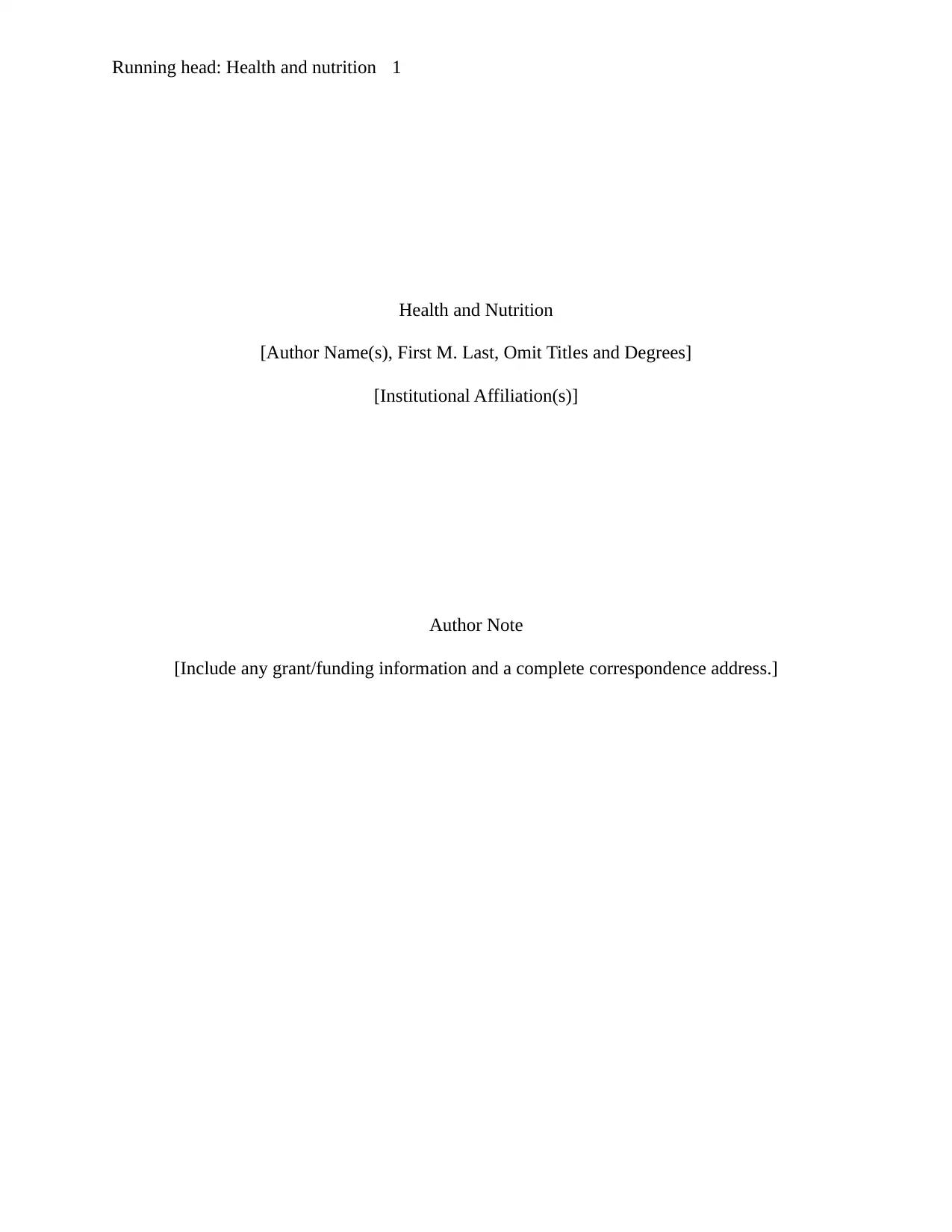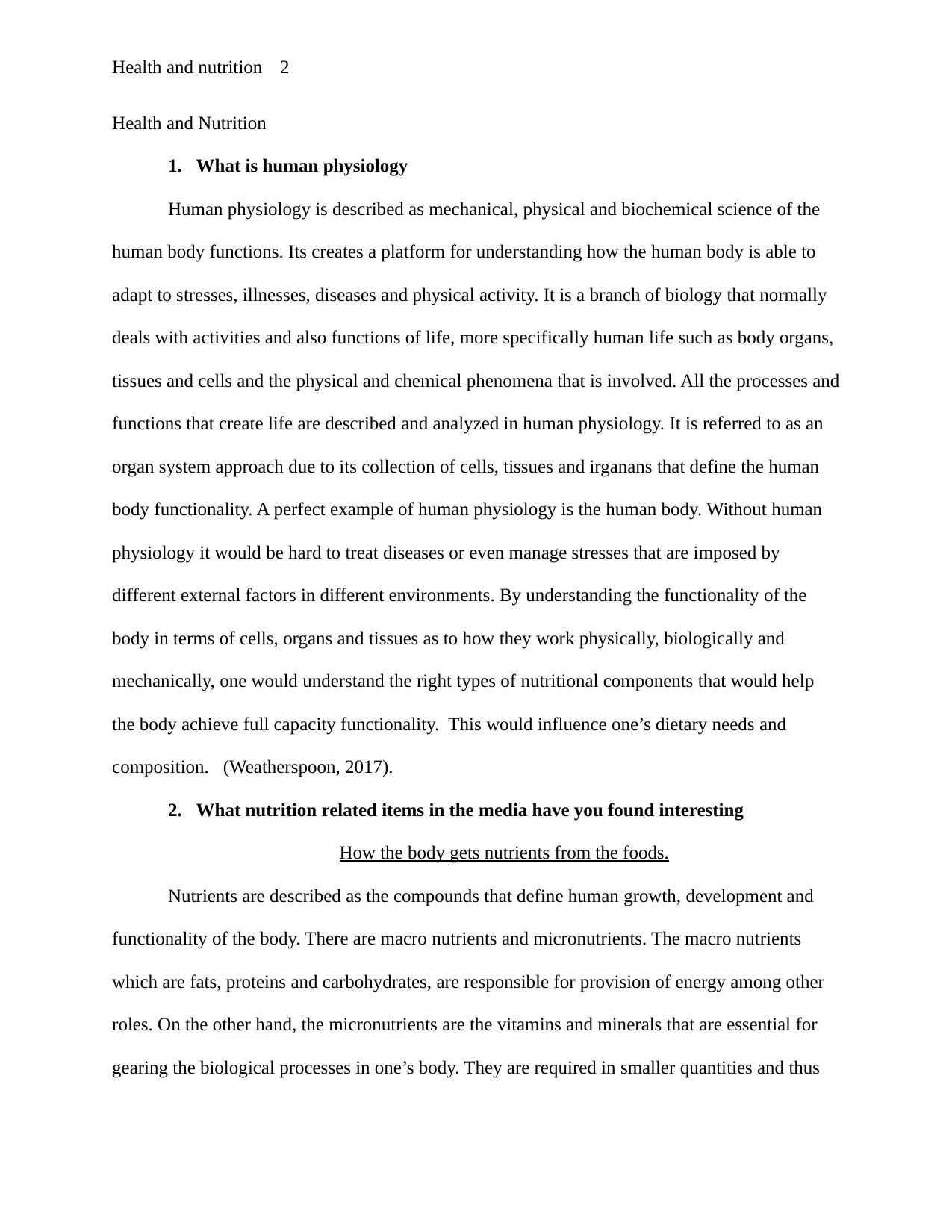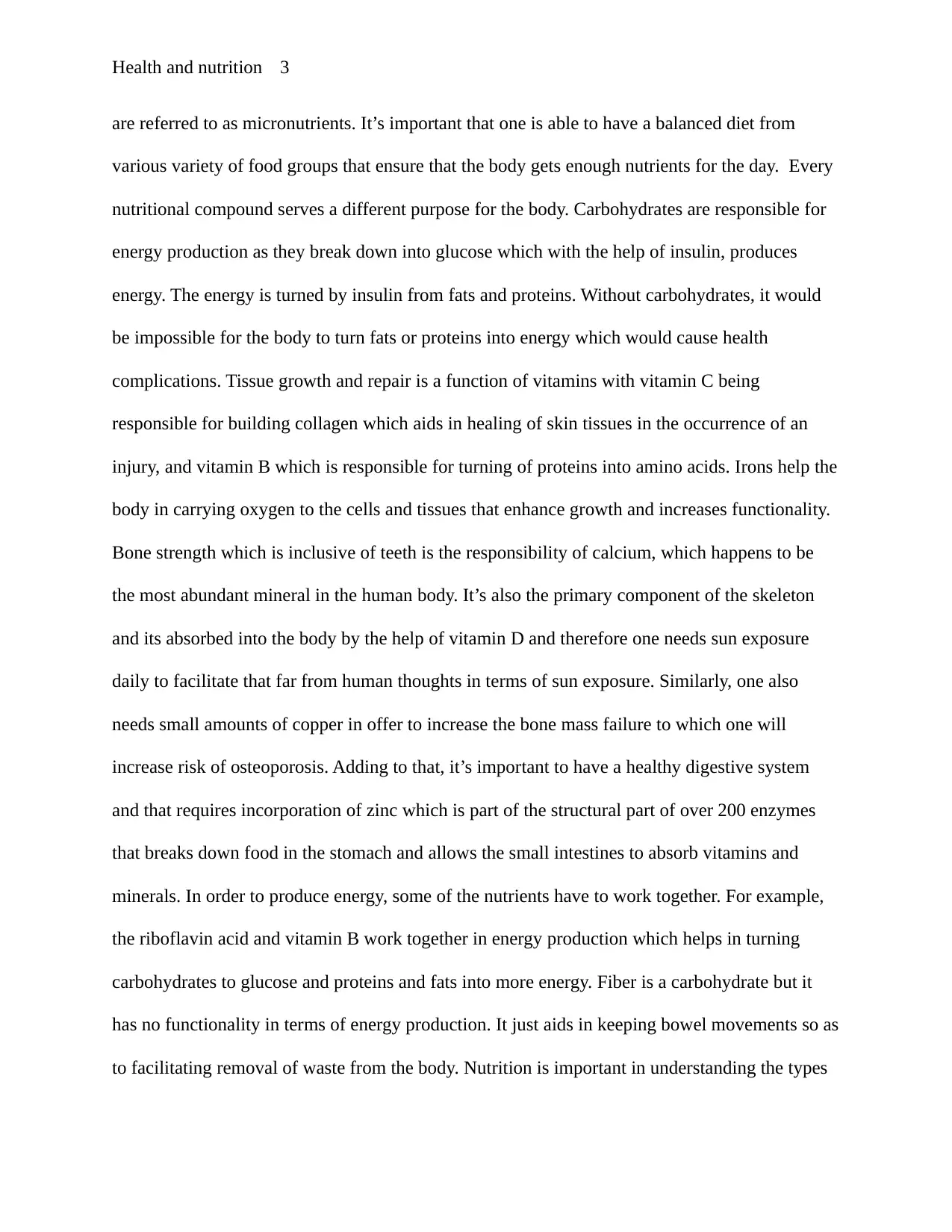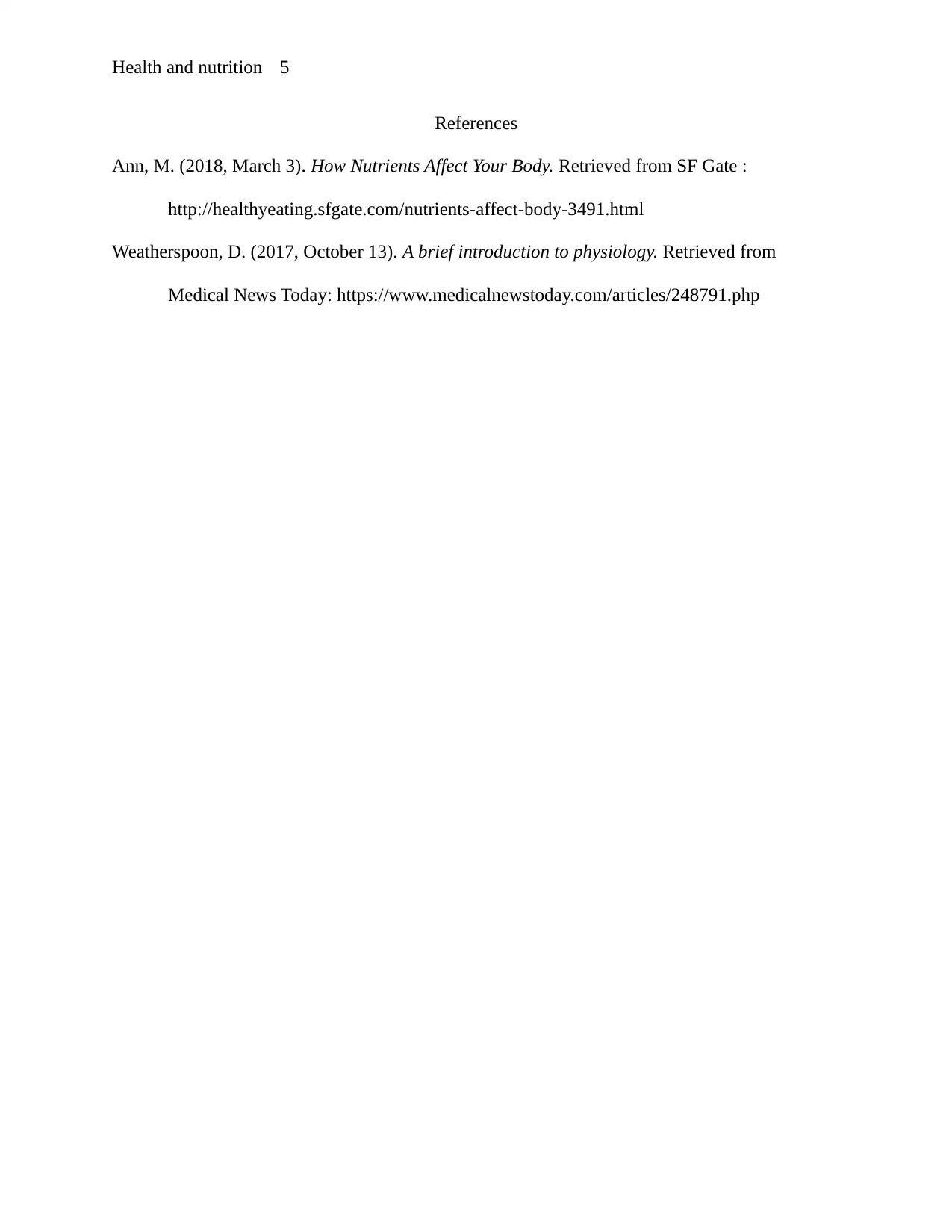Understanding Human Physiology: The Vital Role of Nutrition Explored
VerifiedAdded on 2023/06/11
|5
|877
|207
Essay
AI Summary
This essay delves into the intricate relationship between human physiology and nutrition, highlighting the importance of understanding the body's functions to inform dietary needs. It defines human physiology as a multidisciplinary science encompassing mechanical, physical, and biochemical aspects of the human body, emphasizing its role in adapting to stresses, illnesses, and physical activity. The essay also explores the significance of various nutrients, including macronutrients like fats, proteins, and carbohydrates, and micronutrients like vitamins and minerals, in supporting bodily functions such as energy production, tissue repair, and bone strength. It underscores the necessity of a balanced diet to ensure the body receives adequate nutrients for optimal functionality and overall health, referencing the media's role in disseminating nutritional information.

Running head: Health and nutrition 1
Health and Nutrition
[Author Name(s), First M. Last, Omit Titles and Degrees]
[Institutional Affiliation(s)]
Author Note
[Include any grant/funding information and a complete correspondence address.]
Health and Nutrition
[Author Name(s), First M. Last, Omit Titles and Degrees]
[Institutional Affiliation(s)]
Author Note
[Include any grant/funding information and a complete correspondence address.]
Paraphrase This Document
Need a fresh take? Get an instant paraphrase of this document with our AI Paraphraser

Health and nutrition 2
Health and Nutrition
1. What is human physiology
Human physiology is described as mechanical, physical and biochemical science of the
human body functions. Its creates a platform for understanding how the human body is able to
adapt to stresses, illnesses, diseases and physical activity. It is a branch of biology that normally
deals with activities and also functions of life, more specifically human life such as body organs,
tissues and cells and the physical and chemical phenomena that is involved. All the processes and
functions that create life are described and analyzed in human physiology. It is referred to as an
organ system approach due to its collection of cells, tissues and irganans that define the human
body functionality. A perfect example of human physiology is the human body. Without human
physiology it would be hard to treat diseases or even manage stresses that are imposed by
different external factors in different environments. By understanding the functionality of the
body in terms of cells, organs and tissues as to how they work physically, biologically and
mechanically, one would understand the right types of nutritional components that would help
the body achieve full capacity functionality. This would influence one’s dietary needs and
composition. (Weatherspoon, 2017).
2. What nutrition related items in the media have you found interesting
How the body gets nutrients from the foods.
Nutrients are described as the compounds that define human growth, development and
functionality of the body. There are macro nutrients and micronutrients. The macro nutrients
which are fats, proteins and carbohydrates, are responsible for provision of energy among other
roles. On the other hand, the micronutrients are the vitamins and minerals that are essential for
gearing the biological processes in one’s body. They are required in smaller quantities and thus
Health and Nutrition
1. What is human physiology
Human physiology is described as mechanical, physical and biochemical science of the
human body functions. Its creates a platform for understanding how the human body is able to
adapt to stresses, illnesses, diseases and physical activity. It is a branch of biology that normally
deals with activities and also functions of life, more specifically human life such as body organs,
tissues and cells and the physical and chemical phenomena that is involved. All the processes and
functions that create life are described and analyzed in human physiology. It is referred to as an
organ system approach due to its collection of cells, tissues and irganans that define the human
body functionality. A perfect example of human physiology is the human body. Without human
physiology it would be hard to treat diseases or even manage stresses that are imposed by
different external factors in different environments. By understanding the functionality of the
body in terms of cells, organs and tissues as to how they work physically, biologically and
mechanically, one would understand the right types of nutritional components that would help
the body achieve full capacity functionality. This would influence one’s dietary needs and
composition. (Weatherspoon, 2017).
2. What nutrition related items in the media have you found interesting
How the body gets nutrients from the foods.
Nutrients are described as the compounds that define human growth, development and
functionality of the body. There are macro nutrients and micronutrients. The macro nutrients
which are fats, proteins and carbohydrates, are responsible for provision of energy among other
roles. On the other hand, the micronutrients are the vitamins and minerals that are essential for
gearing the biological processes in one’s body. They are required in smaller quantities and thus

Health and nutrition 3
are referred to as micronutrients. It’s important that one is able to have a balanced diet from
various variety of food groups that ensure that the body gets enough nutrients for the day. Every
nutritional compound serves a different purpose for the body. Carbohydrates are responsible for
energy production as they break down into glucose which with the help of insulin, produces
energy. The energy is turned by insulin from fats and proteins. Without carbohydrates, it would
be impossible for the body to turn fats or proteins into energy which would cause health
complications. Tissue growth and repair is a function of vitamins with vitamin C being
responsible for building collagen which aids in healing of skin tissues in the occurrence of an
injury, and vitamin B which is responsible for turning of proteins into amino acids. Irons help the
body in carrying oxygen to the cells and tissues that enhance growth and increases functionality.
Bone strength which is inclusive of teeth is the responsibility of calcium, which happens to be
the most abundant mineral in the human body. It’s also the primary component of the skeleton
and its absorbed into the body by the help of vitamin D and therefore one needs sun exposure
daily to facilitate that far from human thoughts in terms of sun exposure. Similarly, one also
needs small amounts of copper in offer to increase the bone mass failure to which one will
increase risk of osteoporosis. Adding to that, it’s important to have a healthy digestive system
and that requires incorporation of zinc which is part of the structural part of over 200 enzymes
that breaks down food in the stomach and allows the small intestines to absorb vitamins and
minerals. In order to produce energy, some of the nutrients have to work together. For example,
the riboflavin acid and vitamin B work together in energy production which helps in turning
carbohydrates to glucose and proteins and fats into more energy. Fiber is a carbohydrate but it
has no functionality in terms of energy production. It just aids in keeping bowel movements so as
to facilitating removal of waste from the body. Nutrition is important in understanding the types
are referred to as micronutrients. It’s important that one is able to have a balanced diet from
various variety of food groups that ensure that the body gets enough nutrients for the day. Every
nutritional compound serves a different purpose for the body. Carbohydrates are responsible for
energy production as they break down into glucose which with the help of insulin, produces
energy. The energy is turned by insulin from fats and proteins. Without carbohydrates, it would
be impossible for the body to turn fats or proteins into energy which would cause health
complications. Tissue growth and repair is a function of vitamins with vitamin C being
responsible for building collagen which aids in healing of skin tissues in the occurrence of an
injury, and vitamin B which is responsible for turning of proteins into amino acids. Irons help the
body in carrying oxygen to the cells and tissues that enhance growth and increases functionality.
Bone strength which is inclusive of teeth is the responsibility of calcium, which happens to be
the most abundant mineral in the human body. It’s also the primary component of the skeleton
and its absorbed into the body by the help of vitamin D and therefore one needs sun exposure
daily to facilitate that far from human thoughts in terms of sun exposure. Similarly, one also
needs small amounts of copper in offer to increase the bone mass failure to which one will
increase risk of osteoporosis. Adding to that, it’s important to have a healthy digestive system
and that requires incorporation of zinc which is part of the structural part of over 200 enzymes
that breaks down food in the stomach and allows the small intestines to absorb vitamins and
minerals. In order to produce energy, some of the nutrients have to work together. For example,
the riboflavin acid and vitamin B work together in energy production which helps in turning
carbohydrates to glucose and proteins and fats into more energy. Fiber is a carbohydrate but it
has no functionality in terms of energy production. It just aids in keeping bowel movements so as
to facilitating removal of waste from the body. Nutrition is important in understanding the types
⊘ This is a preview!⊘
Do you want full access?
Subscribe today to unlock all pages.

Trusted by 1+ million students worldwide

Health and nutrition 4
of foods and also the quotients of foods that are necessary in helping the body to function to full
capacity to avoid illness and be able to navigate any environmental influences. (Ann, 2018).
of foods and also the quotients of foods that are necessary in helping the body to function to full
capacity to avoid illness and be able to navigate any environmental influences. (Ann, 2018).
Paraphrase This Document
Need a fresh take? Get an instant paraphrase of this document with our AI Paraphraser

Health and nutrition 5
References
Ann, M. (2018, March 3). How Nutrients Affect Your Body. Retrieved from SF Gate :
http://healthyeating.sfgate.com/nutrients-affect-body-3491.html
Weatherspoon, D. (2017, October 13). A brief introduction to physiology. Retrieved from
Medical News Today: https://www.medicalnewstoday.com/articles/248791.php
References
Ann, M. (2018, March 3). How Nutrients Affect Your Body. Retrieved from SF Gate :
http://healthyeating.sfgate.com/nutrients-affect-body-3491.html
Weatherspoon, D. (2017, October 13). A brief introduction to physiology. Retrieved from
Medical News Today: https://www.medicalnewstoday.com/articles/248791.php
1 out of 5
Related Documents
Your All-in-One AI-Powered Toolkit for Academic Success.
+13062052269
info@desklib.com
Available 24*7 on WhatsApp / Email
![[object Object]](/_next/static/media/star-bottom.7253800d.svg)
Unlock your academic potential
Copyright © 2020–2025 A2Z Services. All Rights Reserved. Developed and managed by ZUCOL.





